Italy Roundtable: Italy's Active Volcanoes
This month, the Italy Roundtable bloggers decided to get elemental – we each chose one of the Greek classical elements to apply to Italy in some way. Maybe because Italy’s in the midst of the coldest winter it has experienced in 27 years, maybe because my favorite color is orange, maybe by pure chance, I’ve chosen the element of FIRE. And what that brings me to this month is, then:
Volcanoes in Italy
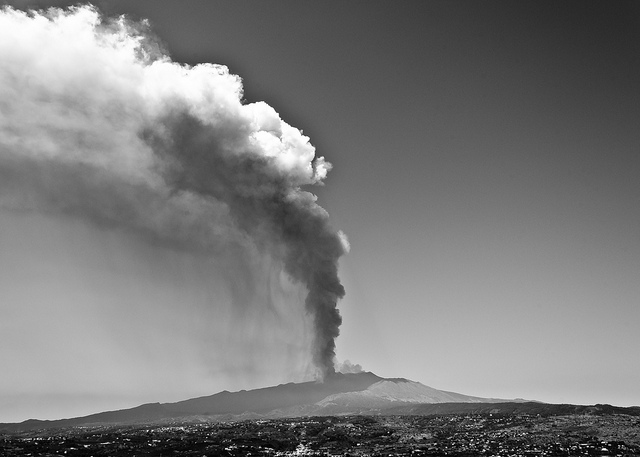
Travelers may more frequently associate Italy with its historic monuments and coastal views, but a quick peek at a topographical map of the peninsula reveals an incredibly mountainous country, indeed. Almost the entire border of Italy with its European neighbors is mountainous, with the Alps to the west and the Dolomites to the east. The Apennines run nearly the length of the entire boot, and even the mountains on the island of Sicily are an extension of the Apennine range. It should come as no surprise, then, that at least a few of those mountains are actually volcanoes.
As it happens, Italy is home to the only active volcanoes in mainland Europe – and it’s got quite a few. Some of these volcanoes are islands (and occupy pretty much all the land area on the island), and some of them are so active they’re listed as having “continuous activity” – a tempting designation, no doubt, if you’re an adventurous traveler with a penchant for eruption photos.
Active Volcanoes in Italy
Italy has three active volcanoes, all of which are in southern Italy. There’s a host of inactive volcanoes in Italy, too, but since those can just as easily be called “mountains” or “hills” when they’re not apt to burp ash or lava, we’ll stick to the active volcanoes for the purposes of this article. Here’s a bit more about each of Italy’s active volcanoes, including where they are and how you can visit.
Mount Etna – Sicily
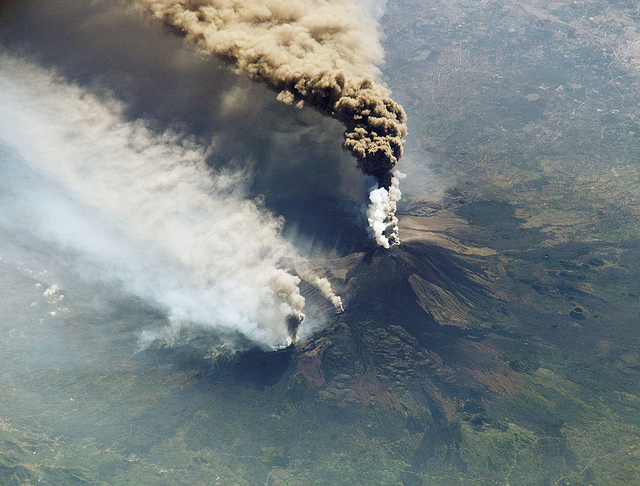
Italy’s largest and most active volcano is Mount Etna, near Sicily‘s eastern coast, standing at over 10,900ft. It also happens to be one of the most active volcanoes on earth – it wears its “continuous activity” label with gusto. Etna was named one of 16 “Decade Volcanoes” by the United Nations, which recommended taking a closer look at the volcanoes listed because of their tendency to have particularly destructive eruptions but also how close they are to populated areas.
Mount Etna may be in a constant state of erupting, but the kinds of eruptions aren’t all the same. Etna has a history of producing great clouds of gas and ash (pyroclastic flow) as well as fountains of lava. Additionally, there are six craters and hundreds of vents on Mount Etna now, which may produce different kinds of eruptions.
As mentioned, Mount Etna is close to people – there are towns surrounding the base of the mountain, and the city of Catania lies within 30km of the peak. The last time an eruption from Etna was responsible for destroying a town was in 1928, but lava has damaged or destroyed countless buildings and transportation lines since.

Mount Etna: Visitor Information
The point from which most tours of the volcano depart is Rifugio Sapienza, roughly 4,500ft from the summit on the south side of the mountain. Note that if you’d like to stay for longer than a regular day tour, Rifugio Sapienza is a true Italian rifugio – a mountain lodge providing rustic accommodation to hikers.
Buses run daily from Catania and Nicolosi to the rifugio, and there’s also a big parking lot where you can leave your car (for a fee) if you’ve got a rental. There are also organized day tours you can book from the nearby resort area of Taormina, Nicolosi, and other area towns – these vary in terms of difficulty, so be sure to ask how strenuous the tour is before you book. Day tours range in price depending on the starting point and what’s included, but there are a few in the €35-75 per person range. Longer tours and those that involve more actual trekking cost more.
Tours of Mount Etna leave from Rifugio Sapienza when the weather permits – if the weather is inclement, experienced mountain hikers can explore on foot, but be warned it can get extremely cold on Etna. In fact, during the winter, Etna is a popular ski destination in Italy. Tours departing from Rifugio Sapienza are roughly €60 per person.
You can also take the train around the volcano on the private Ferrovia Circumetnea – it doesn’t climb the mountain, but it circles the base and you’ll get plenty of great views of Mount Etna (weather permitting, of course). A Catania-Riposto-Catania train ticket is €11.60 and you’ll find a PDF of the train timetable here.
Stromboli – Aeolian Islands

If you think “stromboli” sounds more like some kind of baked pasta dish you might find on the menu at Olive Garden than an Italian volcano, you’re not alone. It is, in fact, a bastardized Italian-American foodstuff, but the original Stromboli is a volcanic island just off the northern coast of Sicily.
Stromboli is one of the Aeolian Islands, all eight of which were formed by volcanic activity. Two of the islands are considered active volcanoes today. Vulcano (appropriately named) is technically “active,” although it last erupted in the late 1800s, so is listed as “dormant.” Stromboli, on the other hand, is (like Mount Etna) in a state of continuous volcanic activity. Most of the eruptions don’t involve lava flows, although most do produce spurts of lava-like rocks – these are particularly spectacular at night, when the rocks glow orange in the dark.
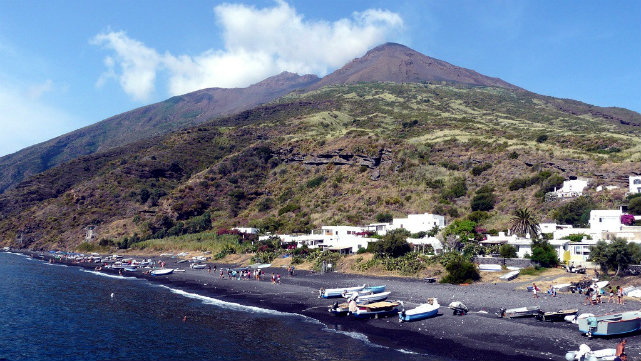
Mount Stromboli: Visitor Information
Mount Stromboli makes up the entirety of the island of Stromboli, rising in a nearly-perfect triangular shape out of the sea and standing at more than 3,000ft, but there’s still a bit of room at the base of the mountain for a few small villages. The only way to reach Stromboli is by boat – there’s regular ferry service connecting the island to the others in the Aeolian chain as well as to Sicily. There are no cars, buses, or trains on the island, so once you get there you’ll be doing a lot of walking (or riding a scooter, or the small three-wheeled Apes).
There are a few hotels on Stromboli, and a few locals who rent out rooms, although most visitors take day tours to Stromboli and don’t spend the night. Note that in order to climb to the summit, you’ll need to be hiking with a guide. You can hire a guide on the island.
Mount Vesuvius – Campania
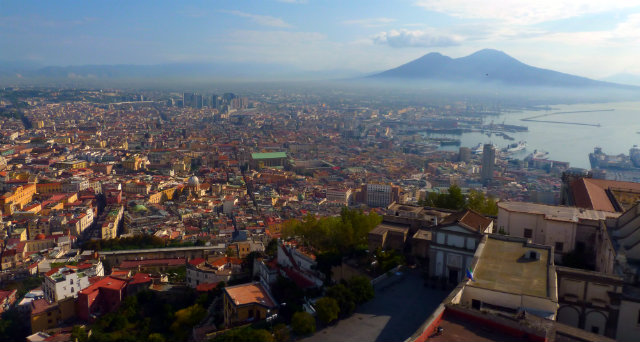
photo by Jessica Spiegel and may not be used without permission
Perhaps Italy’s most famous volcano is Mount Vesuvius, whose 79AD eruptions were responsible for burying and preserving the cities of Pompeii and Herculaneum, among others. The mountain still looms large over Campania, and still poses a volcanic threat. While the other two active volcanoes listed above are in a constant state of eruption, Vesiuvius is not – the last major eruption was in 1944. Still, Vesuvius was named one of the UN’s 16 “Decade Volcanoes” (like Mount Etna) for the severity of its eruptions in the past and for how close it lies to population centers.
While you can’t see Mount Vesuvius, which stands at just over 4,200ft and less than six miles from Naples, from the historic center of of the city, it’s almost impossible to miss if you’re not standing in narrow streets between tall buildings. Get onto a nearby hill or a ferry headed for Sorrento and you can clearly see not just the mountain but the houses that climb up its slopes. The entire population of Naples, let alone the cities surrounding it, would be in jeopardy if Vesuvius were to erupt – yet efforts to convince people to move (even offering them cash to do so) have as yet been largely unsuccessful. Vesuvius remains a quiet threat, and authorities hope the warning systems and evacuation plans they’ve developed do the trick when they’re needed.
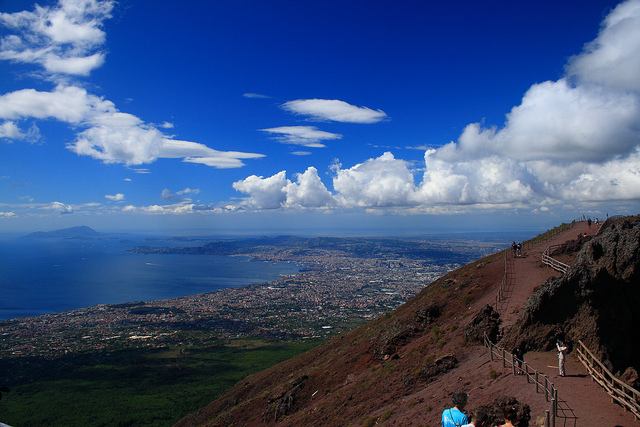
Mount Vesuvius: Visitor Information
You can get to Mount Vesuvius by using the Circumvesuviana train and getting off at either the Ercolano Scavi or Pompei Scavi stations. From each of those stations, there are buses that run trips up to Vesuvius regularly (more often from the Pompei station than from Ercolano), and tickets for the bus cost under €10. You can opt for a private taxi to take you up the mountain instead, although this is more expensive. Note that from the drop-off point for both buses and taxis (the entrance to the national park) you’ll need to hike quite a distance uphill before you get to enjoy the views. Getting into the national park costs €6.50 per person.
Other Voices from the Italy Blogging Roundtable
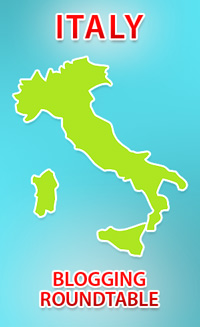 What elemental aspect of Italy did the other members of the Italy Blogging Roundtable write about? Find out by clicking on their links below.
What elemental aspect of Italy did the other members of the Italy Blogging Roundtable write about? Find out by clicking on their links below.
- ArtTrav – Destructive Elements – Italian churches damaged by earth, water, air and fire
- At Home in Tuscany – The Elements and the Seasons: Fire and Water
- Brigolante – Earth: 47, Morto che Parla
- Italofile – Braving the Elements: A Rare Snowfall in Rome
photos not credited within the article are by: alexbravewolf, NASA/Johnson Space Flight Center/Image Science & Analysis Laboratory, alexbravewolf, giopuo, Neuwieser, Averain